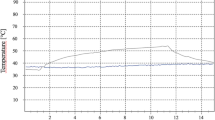Abstract
In otorhinolaryngology, dermatology and reconstructive surgery biomaterials as implants and a variety of lasers are used. Laser light applied near to an implant could have the risk to damage these materials. Therefore, their resistance exposed to laser light is of interest. A diode laser emitting at 940 nm and a CO2 laser were used to investigate its effects to the biomaterials Bioverit®, Medpor® and Palacos®, and in addition, an excised implant containing Medpor® and nasal turbinate tissue, excised and fixed in formalin. The macro- and microscopic changes of the material, temperature development during laser energy application in dependency to distance of fibre and material, time of exposure and applied power were investigated. Interaction of diode laser light with Bioverit® (0 mm distance, 360 s, 10 W, 3,600 J) resulted in minimal microscopic effects in direct contact of with the fibre. Using Medpor® (1 mm, 10s, 10 W, 100 J) resulted in melting and perforation. In the case of Palacos® (0.6 mm, 10s, 10 W, 100 J), melting occurred creating a flat excavation. The effect to Medpor® in nasal turbinate (1–2 mm, 10s, 10 W, 100 J) showed tissue denaturation and carbonisation and creation of a hole. The interaction of the CO2 laser with Bioverit® (3 cm, 0.5, 1 and 5 s, 2, 10 or 20 W) induced melting and discolouring resulting finally in a perforating hole. Depending on the material, first damage starts 10 s after an impact of 100 J (threshold value). So interaction between laser energy and biomaterials occurs. This should be carefully considered during clinical laser treatments especially nearby implants.








Similar content being viewed by others
References
Binyamin G, Shafi BM, Mery CM (2006) Biomaterials: a primer for surgeons. Semin Pediatr Surg 15(4):276–283
Royo J, Urdiales F, Moreno J, Al-Zarouni M, Cornejo P, Trelles MA (2011) Six-month follow-up multicenter prospective study of 368 patients, phototypes III to V, on epilation efficacy using an 810-nm diode laser at low fluence. Lasers Med Sci 26(2):247–255
Astner S (2009) Clinical applicability of a 1,450-nm diode laser as adjunctive treatment for refractory acne. G Ital Dermatol Venereol 144(6):629–638
Yukna RA (2011) Lasers in periodontal therapy. Todays FDA 23(3):40–41
Havel M, Sroka R, Englert E, Stelter K, Leunig A, Betz CS (2012) Intraindividual comparison of 1,470 nm diode laser versus carbon dioxide laser for tonsillotomy: a prospective, randomized, double blind, controlled feasibility trial. Lasers Surg Med 44(7):558–563
Havel M, Sroka R, Leunig A, Patel P, Betz CS (2011) A double-blind, randomized, intra-individual controlled feasibility trial comparing the use of 1,470 and 940 nm diode laser for the treatment of hyperplastic inferior nasal turbinates. Lasers Surg Med 43(9):881–886
Shamsaldeen O, Peterson JD, Goldman MP (2011) The adverse events of deep fractional CO(2): a retrospective study of 490 treatments in 374 patients. Lasers Surg Med 43(6):453–456
PK Chu and X Liu Edt (2000) Solid Free-Form Techniques, Selective Laser Sintering (SLS) using CO2 Laser. Biomaterials Fabrication and Processing Handbook. CRC Press, Boca Raton, p 24–25
Sultan B, Byrne PJ (2011) Custom-made, 3D, intraoperative surgical guides for nasal reconstruction. Facial Plast Surg Clin North Am 19(4):647–653
Remacle M, Jouzdani E, Lawson G, Jamart J (2002) Laser-assisted surgery addressing snoring long-term outcome comparing CO2 laser vs. CO2 laser combined with diode laser. Acta Otorhinolaryngol Belg 56(2):177–182
Kollenberg W (2009) Technische Keramik, Vulkanverlag, page 306
Sevin K, Askar I, Saray A, et al.(2000) Exposure of high-density porous polyethylene (medpor) used for contour restoration and treatment. Br J Oral Maxillofac Surg 38:44–9000
Kuen KD, Ege W, Gopp U (2005) Acrylic Bone Cement: Composition and Properties. Ortho Clinics of North America 36:18–285
Youn JI, Telenkov SA, Kim E, Bhavaraju NC, Wong BJ, Valvano JW, Milner TE (2000) Optical and thermal properties of nasal septal cartilage. Lasers Surg Med 27(2):119–28
Beek JF, Blokland P, Posthumus P, Aalders M, Pickering JW, Sterenborg HJ, van Gemert MJ (1997) In vitro double-integrating-sphere optical properties of tissues between 630 and 1064 nm. Phys Med Biol. 42(11):2255-61
Duck FA. (1990) Physical Properties of Tissue - A comprehensive reference book Academic Press London San Diego - ISBN 0-12-22800-6
Niemz M.H (1996) Laser-Tissue-Interactions; Fundamentals and Applications, Springer Verlag, ISBN : 3-540-60363–8
Hoffman J, Cornelius CP, Groten M, Pröbster L, Pfannenberg C, Schwenzer N (1998) Orbital reconstruction with individually copy-milled ceramic implants. Plast Reconstr Surg 101(3):603–612
Pinkert R (1990) Individually produced open endosseous dental implants made of bioverit glass ceramic. First report on experiences. Zahn Mund Kieferheilk Zentralbl 78(5):411–416
Balossier A, Durand A, Achim VV, Noudel R, Hurel S, Emery E (2011) Reconstruction of the cranial vault using CAD/CAM-fabricated glass bioceramic implants. Neurochirurgie 57(1):21–27
Dost P, Ellermann S, Missfeldt NN, Leyden PJ, Jahnke K (2002) Reconstruction of the stapes superstructure with a combined glass-ceramic (Bioverit) implant in guinea pigs. ORL J Otorhinolaryngol Relat Spec 64(6):429–432
Romo T 3rd, Morris LG, Reitzen SD, Ghossaini SN, Wazen JJ, Kohan D (2009) Reconstruction of congenital microtia-atresia: outcomes with the Medpor/bone-anchored hearing aid-approach. Ann Plast Surg 62(4):384–921
Romo T 3rd, Sclafani AP, Jacono AA (2000) Nasal reconstruction using porous polyethylene implants. Facial Plast Surg 16(1):55–61
Choe KS, Stucki-McCormick SU (2000) Chin augmentation. Facial Plast Surg 16(1):45–54
Hashem FK, Al Homsi M, Mahasin ZZ, Gammas MA (2001) Laryngotracheoplasty using the Medpor implant: an animal model. J Otolaryngol 30(6):334–339
Frodel JL, Lee S (1998) The use of high-density polyethylene implants in facial deformities. Arch Otolaryngol Head Neck Surg 124(11):1219–1223
Stimpson P, Kotecha B (2011) Histopathological and ultrastructural effects of cutting radiofrequency energy on palatal soft tissues: a prospective study. Eur Arch Otorhinolaryngol 268(12):1829–36. doi:10.1007/s00405-011-1634-7
Conflict of interest
There is no conflict of interest
Author information
Authors and Affiliations
Corresponding author
Rights and permissions
About this article
Cite this article
Siedek, V., Nehls, K., zur Nieden, K. et al. Influence of laser light on bioimplants used in otorhinolaryngology. Lasers Med Sci 29, 965–972 (2014). https://doi.org/10.1007/s10103-013-1425-z
Received:
Accepted:
Published:
Issue Date:
DOI: https://doi.org/10.1007/s10103-013-1425-z




